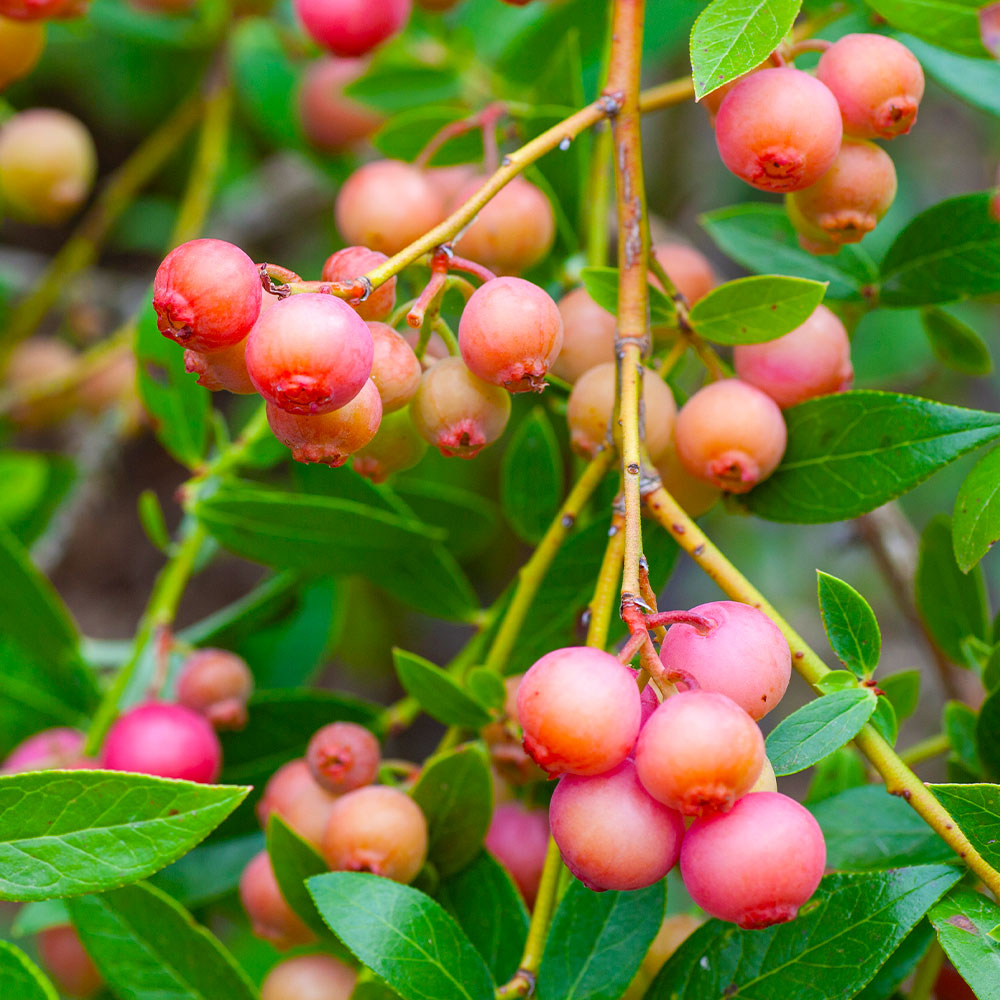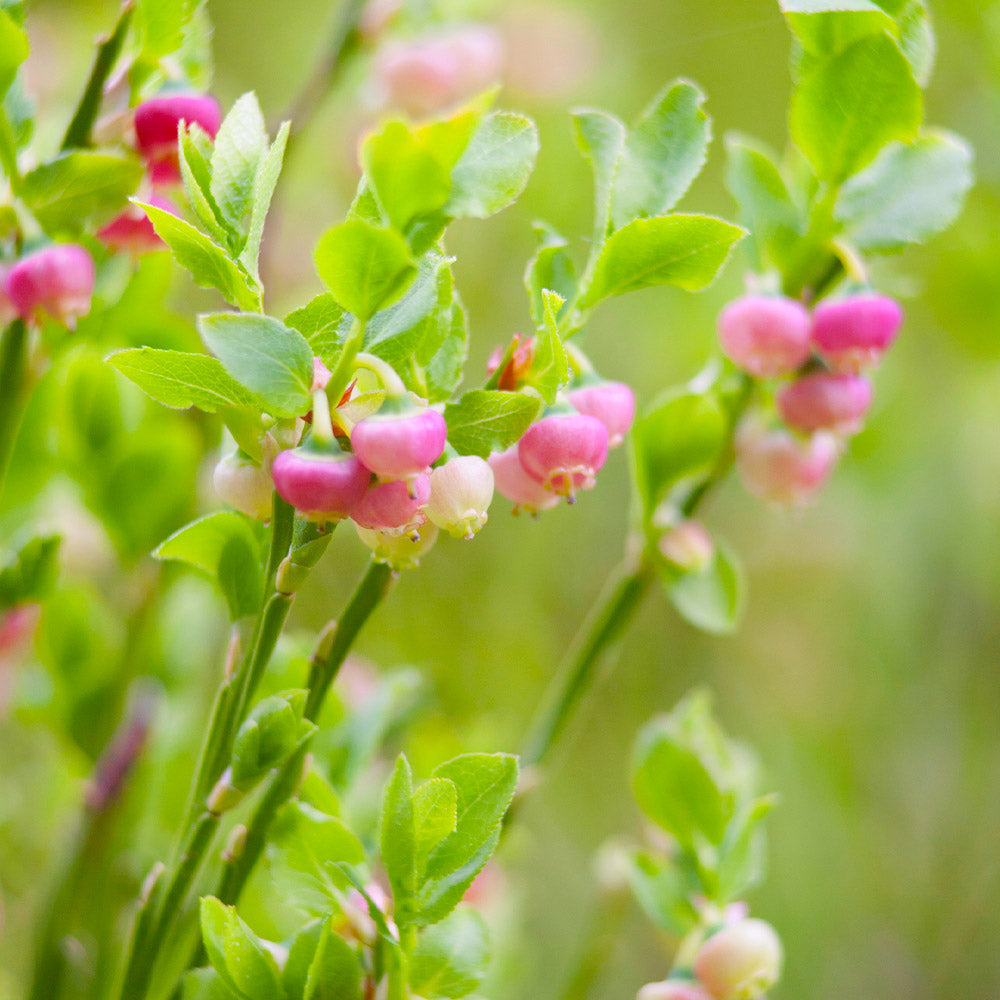Pink, Healthy Blueberries
Considered the Best Tasting Blueberry
Many of our customers have told us that this is the best tasting blueberry they've grown. There are a lot of varieties out there, so that's quite the accolade. The Pink Lemonade Blueberry is firm, juicy, sweet, and has been said to have a slight hint of kiwi flavor. While most blueberries harvest all at once, this one will peak in late summer and continue to produce delicious berries through October. They'll turn pink when they're ready to be picked and are so delicious right off the vine.
Spring, Summer and Autumn Interest
The deep pink berries are the main attraction, but you don't have to wait for harvest season in order to reap the benefits of this amazing bush. Each spring, it produces delicate white and pink flowers. It's a delightful welcome sign of what's to come. As warmer weather approaches, your plant will come alive with a sturdy, healthy base preparing to deliver a large harvest of delicious blueberries in late summer. The pink berries against the deep green leaves is an unusual combination for a blueberry plant. As the summer winds down, you'll get a seamless transition to fall bronze colors in its foliage. It's a great ornamental and does well in gardens amongst varying plants and shrubs.
Improves Health and Beauty
You could spend hundreds of dollars a year on vitamins and supplements from pharmaceutical companies and get some of the same benefits from walking out back and picking these berries from your own shrub. These blueberries are packed with so many health benefits. Loaded with calcium, zinc, Vitamin K, magnesium, and phosphorus, they play a large role in strengthening bones and joints. For those who spend more than you'd like on beauty products and injections, you'll be happy to know that the Pink Lemonade Blueberry will help your body's production of collagen. They have a high volume of Vitamin C, which is known to aid in the skin's elasticity and smooth out wrinkles. These berries are a natural and inexpensive alternative to expensive beauty products.
Order Now
These cold hardy, self-pollinating shrubs are easy to grow and will delight you with 3 seasons of beauty, along with months of the sweetest blueberries you've ever tasted. Nurtured and groomed at our nursery, we don't ship them out until they're ready to perform for you. Get results your first season. Order now for fast delivery.
Planting & Care
The Blueberry is a deciduous shrub. The leaves are spirally arranged, narrow, and start out red-bronze in the spring only to develop into a dark-green. The flowers of the Blueberry are white, and bell-shaped. The fruit is a berry, which is bright pink, and has a thin wax coating.
Seasonal information: Blueberries are grown as an ornamental plant for its fall colors, typically bright orange or red. It is also a highly regarded "super food", containing beneficial vitamins and nutrients.
Location: When selecting a site to plant your Blueberry bush, make sure the site has full sun and drains well. The plant grows best in moist soil, not in soggy soil. Blueberry plants require acidic, well-draining soil. When planted in soils with a pH higher than 5.5, blueberry plants do not absorb nutrients adequately and become more susceptible to disease. Blueberry plants contract moisture-related diseases when exposed to humid conditions or standing water.
Planting instructions: Dig a hole with the shovel that is about twice the size of the root ball of the bush. Make sure the hole is the same depth as the container it comes in. When planting more than one blueberry bush, dig holes that are at least five feet apart in rows that are 10 feet apart. Amend the soil from the hole with peat moss. Make sure to thoroughly mix the peat moss with the soil from the hole. Place the Blueberry bush in the hole. Cover the roots with soil-peat moss mix.
Watering: Your blueberry bushes will need to be watered regularly to make certain that the root system becomes well established. The soil surrounding your tree should be moist, but never saturated. Light green leaves can be a sign of over watering, while drooping leaves can be a sign of both over or under watering.
Fertilization: You do not need to fertilize the Blueberry bush at the time of planting. Fertilize the Blueberry bush twice a year, once in the spring and once after harvest.
Weed Control: Hand-pull weeds near the blueberry shrubs. You can damage the shallow root system with garden tools.
Pests and Disease: Blueberries grow best in acidic soil and are subject to few pests and diseases. If maintained with mulching, the berries can handle temperatures as low as 10 degrees Fahrenheit. Blueberries can mature to the height of three to six feet with a width of up to three feet. The plant has few insect or disease problems; however, birds and squirrels are prone to eating them.
Pruning: Blueberries require only minimal pruning. Lower limbs can be thinned out to keep the fruit from touching the soil, and excessively vigorous upright shoots can be thinned out several feet from the ground to keep the center of the bush open, and to keep the bearing surface within reach. Spindly, weak, or dead branches should be thinned out annually during the dormant season.
Pollination: The Pink Lemonade Blueberry is self-fertile and will produce fruit on its own. However, cross-pollination will produce the best results (both larger berries and larger fruit yield). Planting another blueberry variety that blooms at the same time will be beneficial.






Comment